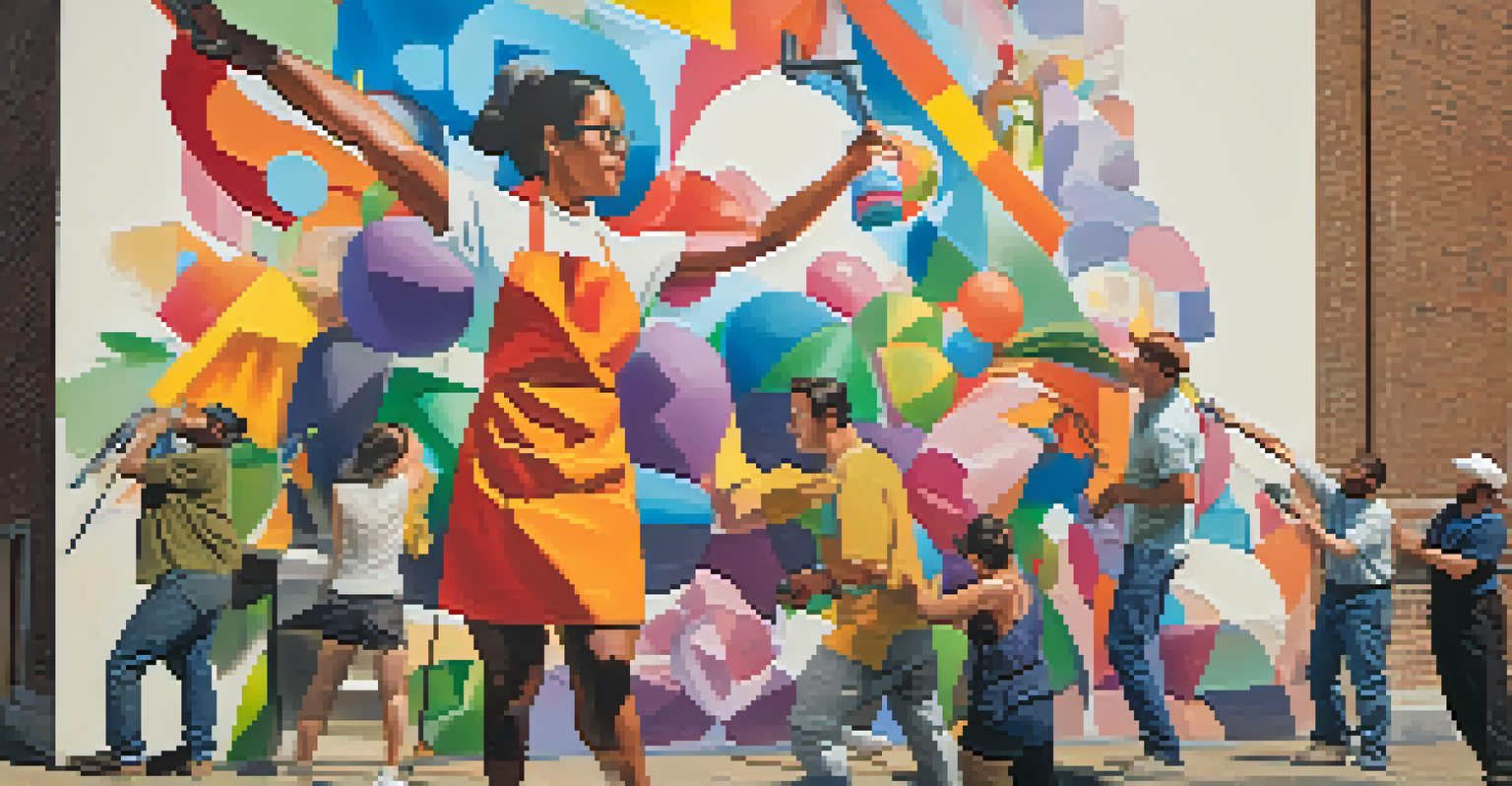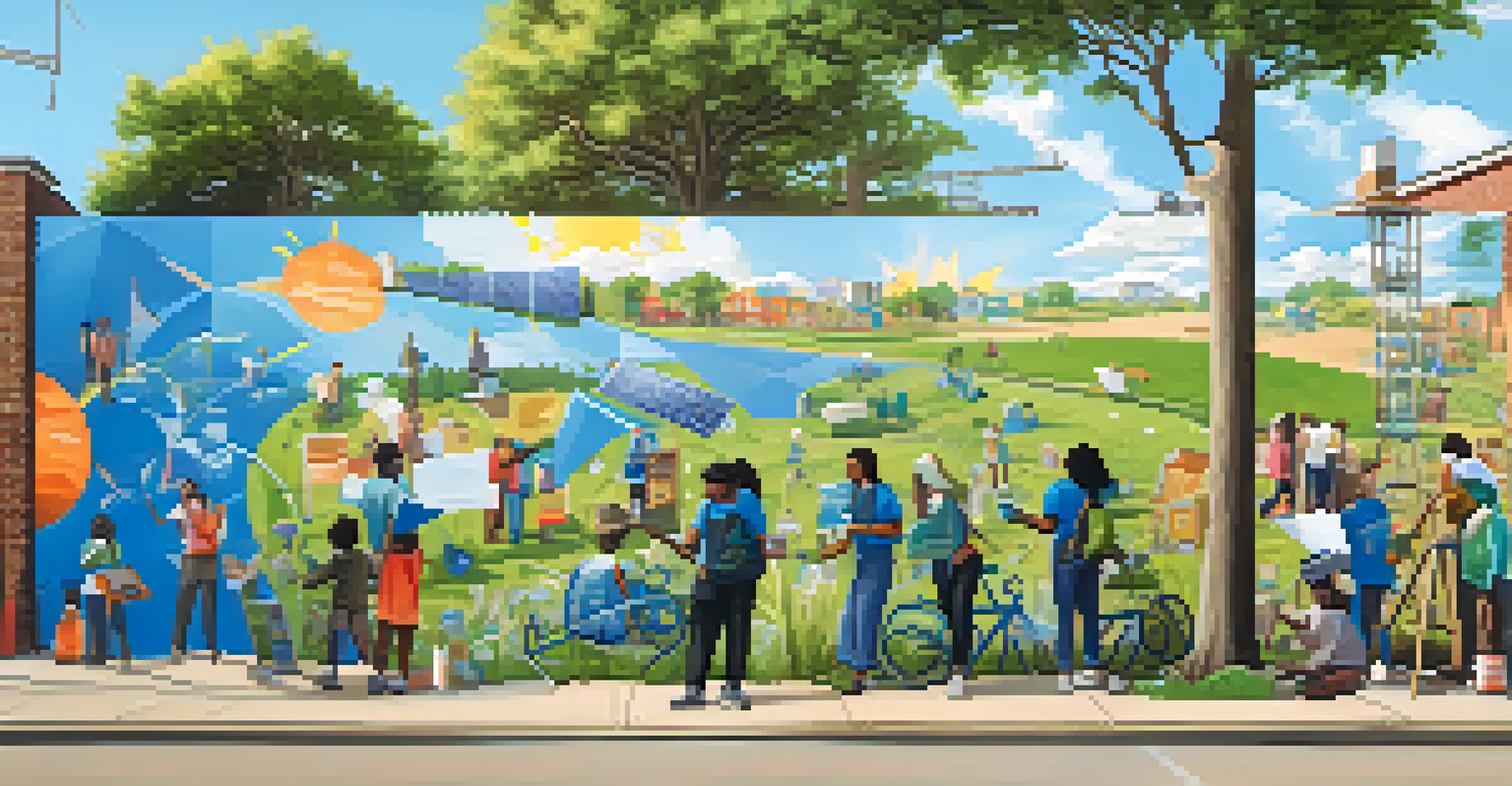Murals with a Message: Urban Art for Environmental Awareness

The Rise of Urban Murals as a Form of Expression
Urban murals have transformed cityscapes, turning bland walls into vibrant canvases. These large-scale artworks often reflect the culture and issues within a community, making them powerful tools for communication. As more artists take to the streets, murals have become a popular medium for addressing social and environmental concerns.
Art is not a mirror to reflect the world, but a hammer with which to shape it.
From bold colors to intricate designs, these murals not only beautify neighborhoods but also spark conversations. They invite passersby to pause and reflect on important topics, such as climate change and pollution. In this way, murals serve as a bridge between art and activism.
As cities become more congested and nature retreats, these artistic expressions remind us of our connection to the environment. They encourage viewers to reconsider their relationship with nature and the responsibilities that come with it.
Murals as Catalysts for Environmental Change
Murals do more than just look good; they can inspire real change in communities. By highlighting environmental issues through art, these murals motivate individuals to take action. For instance, a mural depicting endangered species can raise awareness about wildlife conservation efforts.

Moreover, local organizations often collaborate with artists to create murals that align with sustainability goals. This partnership not only amplifies the message but also fosters a sense of community ownership. People who feel connected to the art are more likely to engage with the cause it represents.
Murals Inspire Community Action
Urban murals engage residents and motivate them to take action on environmental issues.
In many cases, these murals become a rallying point for community initiatives, such as clean-up drives or educational workshops. This synergy between art and activism illustrates the power of public art in driving meaningful change.
Famous Murals Promoting Environmental Awareness
Several iconic murals around the world have made significant impacts on environmental awareness. For example, the 'Earth Guardians' mural in San Francisco showcases the beauty of nature while emphasizing the urgency of protecting it. This mural has become a landmark, drawing attention to local environmental campaigns.
The best way to predict the future is to create it.
Another notable example is the 'Greenway Mural' in Boston, which depicts a lush, thriving ecosystem. This artwork not only beautifies the area but also serves as a reminder of the importance of green spaces in urban environments. It encourages residents to advocate for parks and gardens in their neighborhoods.
These murals often gain media attention, helping to spread their messages even further. As they capture the imagination of viewers, they also create a ripple effect, inspiring similar projects in other cities.
The Role of Community in Mural Projects
Community involvement is crucial in the creation of murals that resonate with local audiences. Artists often engage with residents through workshops and discussions to gather insights about the issues they care about most. This collaborative approach ensures that the murals reflect the community's voice.
When local residents see their stories and concerns depicted on the walls, it fosters a sense of pride and ownership. This connection can lead to increased community engagement and a collective commitment to environmental stewardship. The murals become a symbol of community identity and resilience.
Art as Environmental Advocacy
Murals serve as powerful tools for raising awareness and promoting dialogue about sustainability.
Moreover, these projects can also provide opportunities for education and dialogue about environmental issues. By involving community members in the process, artists help to cultivate a deeper understanding of the challenges facing their environment.
Murals and Public Spaces: An Environmental Impact
Murals have a unique ability to transform public spaces into platforms for environmental education. By choosing themes that highlight sustainability, artists can influence how people interact with their surroundings. For instance, murals that showcase recycling or renewable energy can subtly encourage eco-friendly behaviors.
These artworks can also contribute to the revitalization of neglected areas, making them more inviting and accessible. As people gather to admire the murals, they may also take an interest in maintaining these spaces, leading to cleaner and greener environments.
Furthermore, the presence of art in public places can promote mental well-being, encouraging people to spend more time outdoors. This connection to nature can inspire greater appreciation for the environment, motivating individuals to take steps towards its protection.
Challenges Facing Environmental Murals
Despite their positive impact, environmental murals face several challenges. One major hurdle is funding; artists often rely on grants or donations to bring their visions to life. Without adequate financial support, many projects may never come to fruition, limiting the potential for environmental messages to reach the public.
Additionally, the durability of murals can be a concern, especially in urban areas where vandalism or weather damage may occur. Artists and communities must consider materials and techniques that will withstand the test of time while still delivering powerful messages.
Community Collaboration is Key
Involving local residents in mural projects fosters a sense of pride and ownership in environmental stewardship.
Finally, not all communities may be receptive to these artworks, leading to potential pushback. Navigating local politics and differing opinions can be tricky, but finding common ground is essential for successful mural projects.
The Future of Murals in Environmental Advocacy
As awareness of environmental issues continues to grow, the future of murals in advocacy looks promising. Artists are increasingly using their talents to address pressing concerns, from climate change to biodiversity loss. This trend suggests that public art will play an even more significant role in shaping environmental narratives.
With the rise of social media, murals can quickly gain visibility and reach wider audiences. This digital platform allows for the sharing of stories behind each mural, amplifying their messages and encouraging community involvement. Such exposure can lead to increased funding, collaboration, and support for future projects.

Ultimately, the integration of art and environmental advocacy can inspire a new generation of activists. By capturing the imagination and sparking dialogue, murals can foster a sense of responsibility toward our planet, encouraging individuals to take action for a sustainable future.